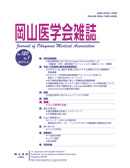

Journal of Okayama Medical Association
Published by Okayama Medical Association<Availability>
Full-text articles are available 3 years after publication.
Permalink : http://escholarship.lib.okayama-u.ac.jp/18592
組織培養による骨髄諸細胞の螢光顕微鏡学的研究 第2編 螢光培養法(Fluorochrominized Bone Marrow Tissue Culture)による正常人血液細胞の生態観察
渡辺 晋
岡山大学医学部平木内科教室
発行日
1960-03-30
抄録
In the present experiment the author conducted the bone marrow tissue of normal persons by the simple method of fluorochrominized bone marrow tissue culture as established in Report 1, and observed the growth zone and various bone marrow cells appearing in the zone. 1. The cells are dense in the central part of the growth zone, and the density gradually decreases towards the periphery, giving off reddish orange fluorescence diffusely with yellow and green fluorescent spots scattered in this zone. 2. Cytoplasma, is green, while mitochondria and various granules give off yellowish green or reddish orange fluorescence. However, the fluorescence of mitochondria is quite trivial, and the nuclei and nucleoles are green but nucleoles give off fluorescence earler than the nuclei. 3, In young cells green fluorescence of cytoplasma is marked, and it grows less distinct as they mature whereas reddish orange granules tend to increase along with the maturation of cells and their size is variegated. 4. In myelogenous cells reddish orange fluorescence of granules is characteristic while yellowish green fluorescence of the nuclei in lymphocytic cells. In mouocytic cells a variety of fluorescence such as green cytoplsama and reddish orange granules agglomerating around the nucleus can be recognized, and likewise fluorescence specific to each cell type can be observed in other cells. 5. The green fluorescence of cytoplasma of erythroblasts is gradually lost along with maturation, and no fluorescence can be recognized in erythrocytes, while substantia reticulofilamentosa of reticulocytes present red fluorescence. 6. When two barrier filters, GG 4 and OG 4 are used together, it is easy to differentiate cells of the erythroblast series from cells of the leucocyte series.
ISSN
0030-1558
NCID
AN00032489
